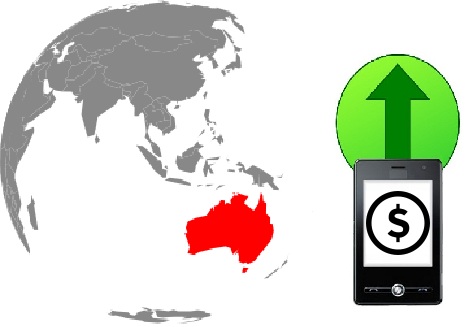PayPal has revealed that over the last three years, the growth in the use of this technology has exploded.
According to the latest Secure Insight report from PayPal, smartphones are becoming an extremely important part of the overall shopping experience, as mobile payments are being greatly embraced by Australians.
This has reached the extent that in three years, they have grown by a factor of 5000 percent.
PayPal explained that this mobile payments growth rose from a base of $37 million. Beyond Australia, the wider online retail market experienced an 11 percent growth to bring its own figure to $36.8 billion. When compared to retail transactions, overall, this is significant, as the total figure had been estimated at only 2 to 3 percent.
This demonstrates that mobile payments are rising far more quickly than transactions as a whole.
 Jeff Clementz, the managing director for PayPal Australia, has explained that the last three years that the company has experienced in retail in the country had been focused on expanding e-commerce. However, he has said that the next phase is now underway and it will concentrate on solutions for the point of sale.
Jeff Clementz, the managing director for PayPal Australia, has explained that the last three years that the company has experienced in retail in the country had been focused on expanding e-commerce. However, he has said that the next phase is now underway and it will concentrate on solutions for the point of sale.
He explained that “Technology development has driven deep structural change in Australian retail.” Clementz also went on to add that “Where once there were few retailers that could truly be called omni-channel, today there are many connecting with consumers in-store, online and on the go.”
The focus that PayPal has now taken is to change the way that the cash register experience works for both retailers and consumers. This aligns with its recent announcement of its PayPal Beacon mobile payments service. Within it, consumers are provided with a hands-free experience. It allows customers to head into a brick and mortar shop, choose their products, and then pay for them at the checkout counter without ever taking their wallets or their devices out of their pockets or purses.
The hope is that these mobile payments will provide a much faster, smoother, and more convenient transaction to enhance shopping, overall, and simplify the purchasing experience to a point that has never before been achieved.
Multimedia messaging services may be the next big channel for communicating with consumers.
Though mobile marketing is still relatively new, there is already an image that comes to mind when the term is spoken, and it usually involves text messages and banner ads that are worked into sites and apps.
Some marketers are beginning to think that the future of this channel, however, is in MMS.
These predictions are not without grounds. The mobile marketing campaigns from large brands such as Kellogg, IKEA, Starbucks, and Bloomingdales, as well as television networks such as ABC, CBS, and Fox, have all included their own elements that include both SMS (text) and multimedia messaging services (MMS). It is the latter that is being viewed by many as the opportunity with the greatest potential and likelihood for growth.
Mobile marketing ads in MMS include any number of different types of content format, including video.
 This mobile marketing prediction is causing many brands, companies, and marketers to begin to direct some of their investments and budgets toward businesses and techniques that involve the use of MMS. It is starting to open the eyes of advertisers to the realization that essentially every cell phone is assured to have at least two apps, which are texting and phone calling. This knowledge helps to provide the perspective needed to properly design campaigns in order to reach the largest number of people.
This mobile marketing prediction is causing many brands, companies, and marketers to begin to direct some of their investments and budgets toward businesses and techniques that involve the use of MMS. It is starting to open the eyes of advertisers to the realization that essentially every cell phone is assured to have at least two apps, which are texting and phone calling. This knowledge helps to provide the perspective needed to properly design campaigns in order to reach the largest number of people.
Regardless of the popularity of actual specific messaging apps, which are also being considered as potential avenues for advertising, MMS is growing faster for mobile marketing simply because it comes as a standard on all of these devices, regardless of model or operating system.
Data from the CTIA (the Wireless Association) has shown that there were 74 billion MMS messages sent by consumers last year. This figure increased at the same time that the number of text messages and talk minutes dropped. Even so, brands have not been exploiting MMS as quickly as was possible. This has left it primed for a sudden explosion in the near future, particularly after the outcomes of recent studies that are showing that this technique helps to effectively reach consumers.
 Jeff Clementz, the managing director for PayPal Australia, has explained that the last three years that the company has experienced in retail in the country had been focused on expanding e-commerce. However, he has said that the next phase is now underway and it will concentrate on solutions for the point of sale.
Jeff Clementz, the managing director for PayPal Australia, has explained that the last three years that the company has experienced in retail in the country had been focused on expanding e-commerce. However, he has said that the next phase is now underway and it will concentrate on solutions for the point of sale.
 This mobile marketing prediction is causing many brands, companies, and marketers to begin to direct some of their investments and budgets toward businesses and techniques that involve the use of MMS. It is starting to open the eyes of advertisers to the realization that essentially every cell phone is assured to have at least two apps, which are texting and phone calling. This knowledge helps to provide the perspective needed to properly design campaigns in order to reach the largest number of people.
This mobile marketing prediction is causing many brands, companies, and marketers to begin to direct some of their investments and budgets toward businesses and techniques that involve the use of MMS. It is starting to open the eyes of advertisers to the realization that essentially every cell phone is assured to have at least two apps, which are texting and phone calling. This knowledge helps to provide the perspective needed to properly design campaigns in order to reach the largest number of people.